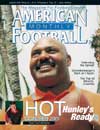AMERICAN FOOTBALL MONTHLY THE #1 RESOURCE FOR FOOTBALL COACHES
Article CategoriesAFM Magazine
|
Attack and ScoreSeattle\'s Kickoff Return SchemeSpecial Teams Coordinator, Seattle Seahawks © More from this issue Our basic K.O. return is predicated on attacking an opponent's left or right flank. We will make minor adjustments or possibly tweak the blocking scheme slightly but we are going to run our left + right return and force the opponent to over-compensate the coverage in some manner to stop our return. When we find the opponent is over-compensating to stop our return, we will run our counter or middle return to take advantage of the coverage adjustments. Otherwise, we will continue to run our base returns. Right Return - Double R4 (Diagram 1) We number coverage team from outside-in L1-L5 and vice-versa on the right R1-R5. Coaching Points: Blocking angles and depth will be determined by kick direction, hang- time, and distance. Normally, our double- team takes place somewhere between the 30-35 yard line and othe....The full article can only be seen by subscribers.
|
|
|||||||
| HOME |
MAGAZINE |
SUBSCRIBE | ONLINE COLUMNISTS | COACHING VIDEOS |
Copyright 2025, AmericanFootballMonthly.com
All Rights Reserved





